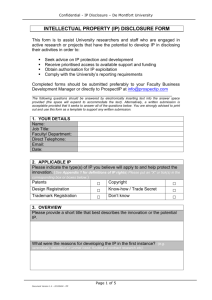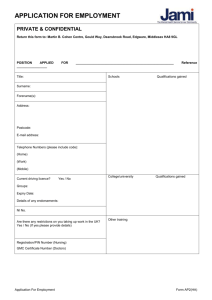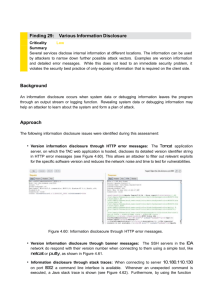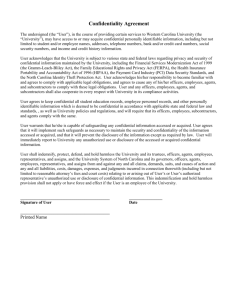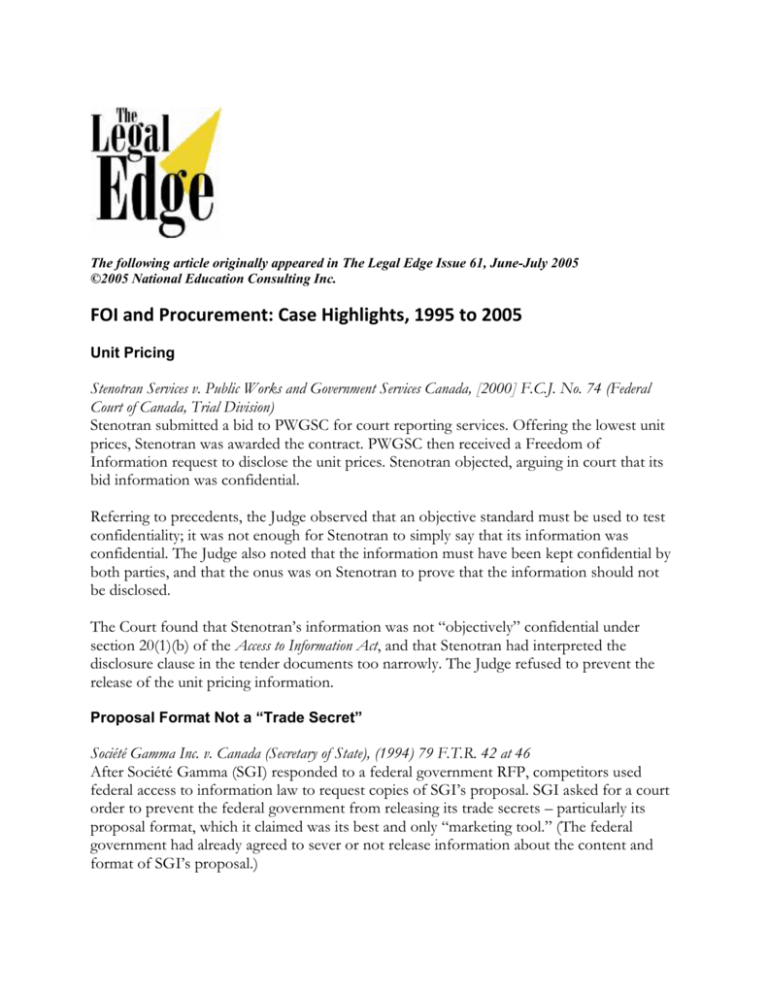
The following article originally appeared in The Legal Edge Issue 61, June-July 2005
©2005 National Education Consulting Inc.
FOI and Procurement: Case Highlights, 1995 to 2005
Unit Pricing
Stenotran Services v. Public Works and Government Services Canada, [2000] F.C.J. No. 74 (Federal
Court of Canada, Trial Division)
Stenotran submitted a bid to PWGSC for court reporting services. Offering the lowest unit
prices, Stenotran was awarded the contract. PWGSC then received a Freedom of
Information request to disclose the unit prices. Stenotran objected, arguing in court that its
bid information was confidential.
Referring to precedents, the Judge observed that an objective standard must be used to test
confidentiality; it was not enough for Stenotran to simply say that its information was
confidential. The Judge also noted that the information must have been kept confidential by
both parties, and that the onus was on Stenotran to prove that the information should not
be disclosed.
The Court found that Stenotran’s information was not “objectively” confidential under
section 20(1)(b) of the Access to Information Act, and that Stenotran had interpreted the
disclosure clause in the tender documents too narrowly. The Judge refused to prevent the
release of the unit pricing information.
Proposal Format Not a “Trade Secret”
Société Gamma Inc. v. Canada (Secretary of State), (1994) 79 F.T.R. 42 at 46
After Société Gamma (SGI) responded to a federal government RFP, competitors used
federal access to information law to request copies of SGI’s proposal. SGI asked for a court
order to prevent the federal government from releasing its trade secrets – particularly its
proposal format, which it claimed was its best and only “marketing tool.” (The federal
government had already agreed to sever or not release information about the content and
format of SGI’s proposal.)
SGI failed to convince the Court that its proposal format was a trade secret or truly
confidential. The SGI proposal was released, with specific information about unit prices,
equipment and personnel deleted.
Information Arising from Negotiations
Jill Schmidt Health Services Inc. v. British Columbia, [2001] B.C.J. No. 79 (B.C. Supreme Court)
Jill Schmidt Health Services Inc. (JSHSI) won a contract to supply health services to the
province. Final financial details were negotiated between the two parties after the
competitive RFP process. Subsequently, the B.C. Nurses’ Union requested detailed financial
information (e.g., management fees, base hourly rates, benefits, safety allowances, bonuses,
etc.). JSHSI strongly objected.
The B.C. Freedom of Information and Protection of Privacy Act is similar to federal and other
provincial legislation, in that it puts the onus on the party resisting disclosure to satisfy a
three-part test. First, disclosure would reveal trade secrets or scientific, technical,
commercial, financial or labour relations information.
Second, the information was supplied in confidence, either implicitly or explicitly. Third,
disclosure would reasonably be expected to harm the originating party’s competitive position
or result in undue financial loss (or gain, by the requestor).
The Information & Privacy Commissioner for British Columbia ordered disclosure. JSHSI
appealed to the B.C. Supreme Court, which found that JSHSI satisfied parts 1 and 3 of the
test, but not part 2: the detailed financial information requested by the Union had, in fact,
been developed from negotiations, not ‘supplied’ by JSHSI. JSHSI argued that the disputed
information fell within the “negotiations” exceptions permitted under prior case law, but the
Judge disagreed. He said that JSHSI had not proven that the financial information had
remained “relatively unchanged” during contract negotiations. The Court upheld the release
order.
Failure to Satisfy Three-Part Test
University of British Columbia and Coca-Cola (Coke), ([2001)] B.C.I.P.C.D. No. 21, Order No. 01-20
A public body can refuse to release its own trade secrets or related commercial, financial or
scientific information, and must not release that type of information supplied by a privatesector contractor, but it still must satisfy the three-part test applied in Jill Schmidt and similar
cases. For five years, UBC had resisted disclosure of its multi-year, exclusive supply
agreement with Coke. A new Information and Privacy Commissioner responded to a request
from the UBC student newspaper for disclosure of the agreement by applying the test.
For part 1 of the test, the Commissioner said that the UBC/Coke supply contract was not a
trade secret, nor did it contain information with an independent economic value. For part 2,
he found that most sections of the agreement under scrutiny were the result of extensive
negotiations between UBC and Coke (as in Jill Schmidt), so the information was not
‘supplied’. For part 3, the Commissioner observed that the evidence provided by UBC and
Coke as to “reasonable expectation of harm” was speculative. And based on evidence
supplied by the student paper, Coke had not suffered “harm” or “undue financial loss” in
the past after the public release of similar agreements.
Colleges and universities are covered by the provincial freedom of information (FOI)
legislation, which takes precedence over contract language, so the Commissioner ordered
UBC to disclose the agreement.
Contracting-Out “Custody” and/or “Control” of Information
Canada Post Corporation v. Canada, (1995) 30 Admin. L.R. (2d) 242 at 244-245
Ontario Criminal Code Review Board v. Hale et al., (1999) 180 D.L.R. (4th) 657
Contracting-out does not eliminate obligations under FOI and protection of privacy
legislation. In these cases, the public bodies still had “custody” and/or “control” of
information or material that was the subject of access to information requests, even though
it was directly in the hands of contractors or employees. Therefore, the material was deemed
accessible to the public.
Personal Records Exempt from “Custody”
Minister of Small Business, Tourism and Culture v. Information and Privacy Commissioner for B.C.,
(2000) 7 C.P.R. (4th) 301
In a somewhat different case, a government liquor store employee maintained a diary about
a customer who had caused disturbances in the store. After being banned from the store, the
customer applied for access to the diary. The B.C. Supreme Court found that the public
body (the liquor store) had no legal right to obtain the diary, since ‘custody’ of the
information did not extend to employees’ personal records – even though this record was
located on the premises of the government liquor store.
Release of Winning Proposal
Promaxis Systems Inc. v. Minister of Public Works and Government Services (Canada), [2002] F.C.J.
No. 1204
Promaxis, an engineering firm, won two contracts with the Department of National Defence
(DND). After a competitor invoked the federal Access to Information Act to obtain a copy of
the DND contract, it requested a copy of the winning proposal. Promaxis objected, saying
that disclosure would allow competitors to calculate its internal labour costs and wage rates,
and possibly underbid Promaxis or hire away key staff.
The Federal Court examined Promaxis’ claims under sections 20(1)(b), (c) and (d) of the Act.
Similar to earlier tests, section 20(1)(b) exempts financial, commercial, scientific or technical
information that is treated consistently as confidential. Citing Société Gamma Inc. v.
Canada (Secretary of State), (1994) 79 F.T.R. 42 at 46, the Federal Court said that
proponents making proposals for government contracts should expect that, once a
competitive procurement is completed, proposals may not be “fully insulated from the
disclosure obligations of the Government of Canada as part of its accountability.” The Court
found that Promaxis’ proposal pricing was not confidential information.
Under section 20(1)(c), information will not be disclosed which might be expected to create
financial loss or gain, or prejudice a competitive position – the ‘harm’ test. The Court found
that Promaxis’ evidence here – an affidavit sworn by a senior company officer – failed to
identify specific harm.
Section 29(1)(d) exempts information that could interfere (i.e., obstruct) contractual or other
negotiations. Promaxis argued that disclosure could jeopardize its future contract
negotiations with employees and subcontractors. The Court found these to be more day-today operational concerns of business, which did not arise from specific contract
negotiations.
Stating that the release of information about government contracts should be the norm, the
Court ruled for release of the winning proposal.
Release of Winning Proposal
Brookfield LePage Johnson Controls v. Canada, [2003] F.C.J. No. 348
BLJC was the successful bidder in 13 procurements to provide facility management services
to the federal government. During the process, BLJC had stated on every page of its
proposals that the information was confidential and proprietary, and disclosure for any other
purpose than the evaluation was prohibited. When a third party sought access to two of
BLJC’s 13 winning proposals under the Access to Information Act, BLJC objected on the
grounds that disclosure would reveal trade secrets and confidential financial and commercial
information.
The Federal Court followed Promaxis, saying that there was nothing unique in BLJC’s
presentation of its proposals, the proposals were not a trade secret, and BLJC’s
characterization of every page of its proposals as confidential diluted its position. The Court
also observed that, when disclosure is the general rule, one cannot contract-out of the Act.
The Court upheld the applicant’s right to obtain a copy of the winning proposals.
Winning Proposal Not Disclosed
High Rise Group Inc. v. Canada, [2003] F.C.J. No. 602
HRGI won a federal government RFP to provide leased office accommodation for 15 years,
with an option to extend the least for a five-year term. The deal also involved options to
purchase.
A third party then requested, under the Access to Information Act, a summary of all the bids,
and a copy of the government’s bid evaluation sheet, showing the scores in each category for
each bid. HRGI objected, saying that, from the evaluation sheet, competitors could calculate
annual rents and purchase option prices in its contract. HRGI also argued that the
information was confidential, and releasing it would seriously harm the company.
In this case, HRGI satisfied the burden of proof: the Federal Court agreed that the
evaluation summaries and the information supplied by HRGI in its proposal were the same,
and the key financial information was confidential. Disclosure was not permitted. In March
2004, the Federal Court of Appeal upheld the decision.
Harm Not Proven by Contractor
Shannex Health Care Management Inc. v. Attorney General of Nova Scotia representing the Nova Scotia
Department of Health, 2004 NSSC 054
Shannex operated five nursing homes in Nova Scotia. It received funding from the
Department of Health (DOH) keyed to a per diem rate. When the DOH received a request
for information on how per diem rates were calculated for all N.S. nursing homes for the
previous year, Shannex objected. When DOH decided to release the information, Shannex
appealed to the N.S. FOIPP Review Office. And when the Office upheld DOH’s decision,
Shannex appealed to the N.S. Supreme Court.
Mr. Justice Edwards used N.S.’s three-part test to determine that Shannex met the first two
parts (i.e., the information was financial and commercial belonging to Shannex, and had
been supplied implicitly in confidence).
However, the Judge found that Shannex had not provided any “detailed and convincing”
evidence to address part 3 (i.e., the harm it would suffer if the information was disclosed).
The disclosure was permitted.
In his decision, the Judge strongly endorsed the purpose of the legislation, saying: “[I]n the
context of a business heavily subsidized by public tax dollars, the public has the right to know how those
dollars are being spent … The recipients of such subsidies should not expect the same degree of confidentiality
that pertains in a competitive unsubsidized market. There must be detailed and convincing evidence to justify
nondisclosure … ”
Harm Not Proven re Performance Incentive
Fuller v. R. et al. v. Sobeys, 2004 NSSC 86
Sobeys provided gross and incremental payroll information to the N.S. Office of Economic
Development (OED), which gave Sobeys a performance-based incentive in the form of a
payroll rebate. The rebate was provided after a verification audit done by the province.
When a third party requested all records relating to that rebate, Sobeys objected.
The N.S. Supreme Court found that the verification audit constituted “advice,” which was
exempted from disclosure, and releasing the names of company officers who had signed
letters would be an unreasonable invasion of privacy. Sobeys met parts 1 and 2 of the threepart test (i.e., the information was commercial or financial and had been supplied in
confidence), but like Shannex, it failed to meet part 3 – the “harm” test.
Quoting Atlantic Highways Corp. v. Nova Scotia, (1997) 162 N.S.R. (2d) (SC) and from
Lavigne v. Canada (Commissioner of Official Languages), 2002 SCC 53, the Judge
quoted, “there must be a clear and direct connection between the disclosure of specific
information and the injury that is alleged.”
The disclosure was allowed.
With research from Vicki Parker in Victoria (250-370-5515), and thanks to Roy A. Nieuwenberg of Clark
Wilson (604-643-3112) and Maureen Sullivan, BA, LL.B. (250-370-0041) for the use of excerpts and information
from past articles written by them for The Legal Edge.
©2005 National Education Consulting Inc.
Reprinted from The Legal Edge Issue 61, June - July, 2005
For subscription and NECI seminar information, visit www.neci-legaledge.com. All rights reserved.
Any reproduction of this article by any means in whole or in part without the express permission of the
ublisher is prohibited.
Tuesday, October 25
Blog: Keyword(s): business drivers in procurement, public sector procurement
What are the key differences between public and private sector procurement?
Business Drivers
Business Drivers
A perhaps more subtle difference between public and private
sector procurement lies in the key overriding considerations that
drive procurement and contracting decisions.
In the private sector, where the primary procurement focus is
profitability, the bottom-line analysis is generally the determining
factor when procurement and contracting decisions are made. The
public sector, on the other hand, is responsible for providing
effective and efficient services to the public; the primary emphasis,
therefore is on the public need, not profit. This often means that a
service or program that would not otherwise be available in the
marketplace may be provided and/or developed to meet the needs
of the public, even though such a procurement decision would not be considered ‘profitable’ in
the eyes of the private sector.
One example that comes to mind would be British Columbia’s Community Assistance Program
(www.gov.bc.ca/meia/online_resource/employment_programs_and_community_services/cap/
) aimed to help the most vulnerable income assistance clients improve their quality of life and
connect with services in their communities. Delivered by contracted service providers in 50
communities throughout the province, the program helps individuals develop positive life skills
and connects them with mental health, housing, substance dependence treatment, legal aid
and family services.



